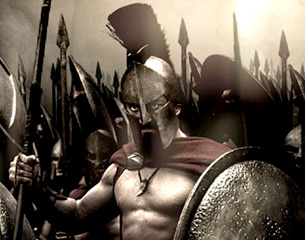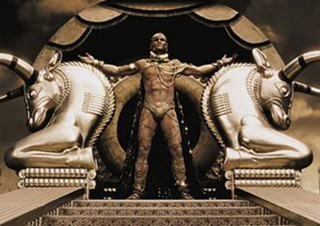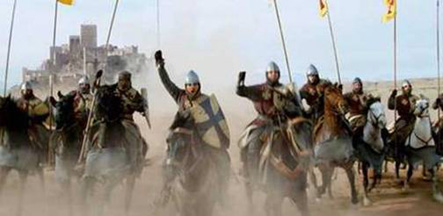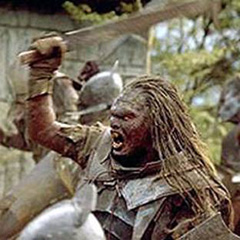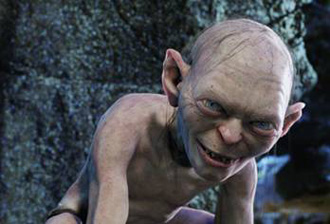Abstract
As well as being historical films, Zack Snyder’s 300 and Ridley Scott’s Kingdom of Heaven both reflect on the value and the danger of historical commemoration and amnesia. The films’ opposing stances on the ‘righteous’ use of history directly link to their differing uses of historical East-West clashes (Thermopylae and the Crusades) as allegorical commentaries on current East-West tensions, specifically the Western occupation of Iraq. Examining these films together, however, illuminates the cross-historical heroic idiom they both share, and thus exposes the drawbacks of the historical periodisation that persists in current approaches to film in medieval and classical studies.
………..
Just before the climactic battle in Zack Snyder’s action-epic 300 (USA 2006), the Spartan King Leonidas (Gerard Butler) prepares his small unit of warriors for a “beautiful death” defending Greece against the invading Persians at the pass of Thermopylae in 481 B.C.E.. Meanwhile, back in Sparta, Queen Gorgo (Lena Headey) stands before the city’s council, urging them to send the army north to support her husband against the Asiatic forces massed under King Xerxes (Rodrigo Santoro). Reminding the council that Xerxes’ aggression was instigated by his father King Darius, she is cut off: “This chamber needs no history lesson, my Queen”, sneers the saturnine councillor Theron (Dominic West), an opponent both of Leonidas and of the war. Moments later, after falsely denouncing Gorgo for adultery, Theron lies dead and discredited, unmasked as a traitor by the purse of Persian coins he rather imprudently carries at his belt. His sneering dismissal of “history lessons” is exposed as the self-interested denial of the corrupt, who fear the righteous condemnation of the historical record.
We already know 300 is a film with a historical setting, but this scene is significant for disclosing the film’s position on the subject of history; or, more precisely, its subscription to the moral-didactic value of history. History’s role, this scene suggests, is to rouse us to right action via its unblinking chronicle of virtue and vice. This advocacy of ‘righteous history’ reaches its culmination in the film’s final scene, when we realise that the account we have witnessed of the Spartan martyrdom at Thermopylae, narrated through the voice-over by the Spartan hoplite Dilios (David Wenham), in fact forms the historical centrepiece of Dilios’s oration to the allied Greek troops as he prepares them for (victorious) battle against the Persians at the Battle of Plataea. Theron’s history-denial is replaced by Dilios’s faith in commemoration through action, as he urges the soldiers “[Leonidas’s] wish was simple: remember us … remember why we died”. Through learning the “history lesson” of Thermopylae, which teaches that “freedom is not free … it comes with the highest of costs, the cost of blood”, the Hellenic soldiery – and the modern Western audiences perched over their muscled shoulders – will understand the necessity of taking up arms in order to “rescue our world” from Eastern “mysticism and tyranny”. Their act of historical remembrance will be, indeed must be, an act of war. The oddly adenoidal British-Australian accent adopted by Wenham in his voice-over, which channels the retro-patriotism of the WWII newsreel, reinforces both the untroubled militarism and the broadly-drawn moral contours of the film’s Hawkish historico-political agenda, which advocates the continued presence of the U.S.-led ‘coalition of the willing’ in the Persian gulf.
Ridley Scott’s Kingdom of Heaven (UK/Spain/USA/Germany 2005), set in the years leading up to the 1187 siege of Jerusalem by Saracen forces under Saladin, also contains a significant scene in which the uses of the past are subjected to reflection. As with Dilios’s speech, this reflection comes in the context of a battle oration. As the massive Saracen forces surround Jerusalem, the film’s hero Balian of Ibelin (Orlando Bloom), a blacksmith-turned-pacifist-Crusader who is now leading the defence of the city, delivers a rousing oration to his contingent of commoners. The speech begins by representing the guilt of the historical past – in this case the Crusaders’ brutal capture of Jerusalem in 1099 – as a burden the living must bear despite their ‘innocent’ distance from events for which they are not personally responsible:
None of us took this city from the Muslims. No Muslim coming before us was born when this city was taken. We fight over an offence we did not give, against those who were not alive to be offended.
Despite the stentorian certainty of their delivery, these lines are striking for the ambiguity of their historicism. On the surface of the speech, the past is presented as unreal, kept alive only by an outdated sense of offence clung to by the victims’ descendants. Yet undergirding this is a conviction that history is a current affair, an inevitable legacy for which the offspring of the guilty must pay.
This conviction is undermined somewhat by what immediately follows. Balian goes on to offer a potted architectural sketch in which the holy places of Jerusalem are taken as exemplars of the culturally relativistic uses to which history is put. In this “history lesson” the Christian inhabitants of Jerusalem are told that “your holy places lie over Jewish temples pulled down by the Romans; Muslim ones lie over yours. Which is most holy? Who has claim?” Answering his own questions, he says “No-one has claim! All have claim!” This proclamation sits at odds with Balian’s former acceptance of the cyclical morality of history. Furthermore, its stirring rhetoric fails to dispel the practical problems of cohabitation raised by its glib secular humanism. If all and none have claim to the Holy City, what is to become of its sacred places? An inter-faith time-share arrangement?
Balian does have a solution, though. Rather than defending “these stones”, he urges his troops to devote themselves to defending “the people living within these walls”. The act of describing Jerusalem as “stones” is, again, fraught with historical ambivalence: on the one hand Balian denudes the city of its historical accretions, stripping it back to a lifeless materiality; on the other hand, the phrase “these stones” evokes the burdening weight of history they contain. But his solution is ultimately profoundly anti-historical: forget the past, focus on the living people who need to be extricated from its tenacious and destructive grip. This sentiment is Balian’s pre-emptive apologia for his later decision to surrender the “stones” of the city to Saladin in order to bargain for the lives of his people, who are granted a safe exodus to Christian soil. In fundamental contradistinction to Dilios’s affirmation of commemoration through combat, Balian’s advocacy of an ethical rejection of history licenses Christendom’s withdrawal from the Middle East – and even, more radically, from the sphere of international politics itself.
The above scenes give us a glimpse into their directors’ awareness of the implications of using cinema as a medium for bringing the past into dialogue with the present. It is striking that none of these characters’ meditations on history appear in the context of private rumination or intimate discussion; rather, all take place before audiences of sizeable, even vast, proportions, in a gesture that both reflexively dramatises the films’ own public acts of historicisation and alludes to the spectatorship of their cinematic audiences. However wilfully naïve or unwittingly incoherent their theories of history might be, they are both films that exhibit a consciousness of the particular possibilities, and limitations, of historical cinema as a vehicle of social commentary and ideological intervention.
Of course this is not the most obvious thing that links these two films. More conspicuously, released only a year apart, they both dramatise iconic historical moments of East-West military conflict – and, moreover, iconic Western ‘noble defeats’ at the hands of Eastern forces – and treat them in ways that unabashedly dialogue with current Western perspectives on the so-called East-West ‘Clash of civilisations’ and U.S. foreign policy in the Middle East. And yet despite this overlap, they have received no comparative discussion. The reasons for this silence are not difficult to divine. First, one is an action-epic while the other is an historical drama, and as such they aim for different sectors of the mainstream viewing market. Second, Kingdom of Heaven has been received as an established auteur’s historical commentary on East-West relations, while 300 has attracted almost universal derision from critics, who routinely place it in the apparently suspect company of comic books (it is adapted from Frank Miller’s 1998 graphic novel of the same name) and video games.[1] Furthermore, their respective popular critical receptions have been so dominated by discussion of their separate ideological investments that there has been little room to accommodate another film of such starkly different colours, despite their comparable content. I wish to argue, however, that the films bear fruitful comparison for the parallel, yet also distinct, ways in which they triangulate their historical meditations with their representations of historical East-West conflict and their engagement with current U.S.-Middle East politics. An examination, furthermore, of the fault-lines that emerge within each film’s triangulation illuminates their divergent responses to the contradictory pressures under which they both labour as historical films.
In the field of academic reception, particularly within analyses of the cinematic representation of the early European past, the critical resistance to comparison has been compounded by a surprisingly unquestioning adherence to historical periodisation within the study of film. This problem has not generally afflicted those scholars who examine individual historical films as exemplars of the genre.[2] But within recent scholarship emerging out of medieval studies and classics, increased acknowledgement of the ‘multi-temporality’ of historical cinematic representation, and challenges to ‘historical accuracy’ as the dominant paradigm for evaluating historical film, have not led to any serious dislodging of the assumption that films set in a particular period are best analysed in relation to other films featuring the same period. Analysis of medievalist films has not so far engaged in sustained evaluation of how this period is presented vis-à-vis other periods. By discussing these two films together, I hope, as a medievalist, to query the residual historical apartheid of this default periodisation.
Focussing alone on characters’ explicit verbal discussions of history is, of course, too reductive a response to the complex medium of historical film, notwithstanding the fact that these discussions are placed into mouths of characters who occupy clear-cut positions within the films’ ideological and moral economies. Although there can be little doubt that audiences are steered firmly toward trusting acceptance of the heroic characters’ perspectives on remembrance or forgetting, and thus toward approval of the courses of action (or inaction) they adopt, both films contain vital aesthetic and narrative elements that appear to destabilise their central characters’ avowed positions on history.
Looking first at 300, we detect a tension between Dilios’s and Gorgo’s advocacy of historical remembrance and the film’s unapologetically simulacral appearance, which parades openly its attenuated relationship to its historical referent. Not content simply to shoot the entire film using the green-screen method that enables background and other details to be created and added digitally, Snyder also eschews a realist aesthetic post-production. Instead of dazzling Aegean vistas we see grim, rocky outcrops with low skies, leaden seas, and a muted palette that evokes not so much the documentary effect of sepia photography as the operatic solarisation of New Romantic pop videos. Richard Alleva attributes the film’s “bronze-tinted, clammy look” to the fact that it takes as its referent its graphic novel antecedent.[3] Slavoj ?i?ek also notes the “closed artificial universe” of the film’s mîse-en-scène, populated by the “cyborg” figures of the Spartan warriors whose bodies have been identically beefed up with hyper-real digitised muscularity. But for him this “uncanny”, synthetic aesthetic primarily reflects the film’s creation of an “autonomous” space in which history has been evacuated and replaced by pure ideology.[4]
The film’s hyper-real aesthetic need not, however, be regarded as antithetical to its commitment to historical commemoration. Rather, it retains an ideal of commemoration which it makes no attempt to separate from ideology: Leonidas does not entreat “remember that we died”, but “remember why we died”. To remember why the Spartans died, it is implied, is to reflect on their defence of ideals that are foundational to Western democracy.
Zizek is not alone in emphasising the unconcealed ideological nature of the film. To take just two examples, Mustapha Marrouchi has described it as a “dawn-of-democracy epic in which violence is marshalled to protect the future of Western civilisation”,[5] while Frank J. Wetta calls it an “epic story of the defense of Western freedom against the forces of Eastern despotism”.[6] It is, moreover, just as common to find assertions that the film trespasses beyond the sphere of ideology into the more pragmatic domain of politics itself. Hywel Williams condemns the film’s “uncritical reflection of neo-con foreign policy”,[7] while Marrouchi expresses his concern about the film’s subscription, via historical “political fable”, to “the Bush administration’s ‘get-them-in-Iraq-before-they-hit-us-here’ rationale”.[8] Where ?i?ek’s analysis differs drastically from other commentaries, however, is in its construal of the film’s ideological affiliation and political message. In opposition to the widely-held view that the film is an apologia for the Western occupation of Iraq, Zizek defends it as a creation of “the real Hollywood Left”. This counter-intuitive but highly persuasive reading of the film as Leftist allegory rests on the argument that 300 operates according to a logic of inversion. Within this logic, Zizek argues, Sparta, as a small state characterised by disciplined militarism and a steely commitment to martyrdom as a defence of homeland and freedom, represents not the West, but rather the Middle East and, more particularly, occupied Iraq. Similarly, we should recognise the United States and its ‘coalition of the willing’ in the film’s representation of the Persian empire as a sexually decadent, multicultural, hubristic superpower whose wealth and superior weaponry mandate its invasion of the smaller state. According to this reading, the film not only sides sentimentally with Iraq, but offers dire prognostication, via the Persian defeat at Plataea, of the nemesis that awaits the U.S. should it persist in its incursions into Islamic states and its occupation of Iraq.
What Zizek’s interpretation illuminates is the instability of the film’s historico-political allegory. This point is corroborated by Peter Bradshaw who, despite his belief that the film is a defence of Western democracy, observes that the film’s historical parallelisms strain under closer examination: in particular “the idea of America having the Spartan underdog status is implausible”.[9] But despite ?i?ek’s seductively tidy series of inversions, two things are missing from his account of the film. First, his strongly narrative emphasis leads him to neglect some significant elements of the film’s visual idiom, in particular its indulgence in an overwrought species of orientalist imagery in its representation of the Persians, the force of which overwhelms any facile equation of these figures with the U.S. It is true that this orientalism is shot through with allusions to American camp: Xerxes’ first appearance on a massive slave-drawn ziggurat resembles nothing so much as the towering black drag queen Ru Paul, sans wig, arriving on a float in a Gay Pride parade. But these allusions are grounded in older and more abiding orientalist stereotypes of the effeminate and elaborately adorned Eastern male.
More importantly, however, while Zizek’s notion of inversion is highly serviceable, it points the film’s political unconscious in the wrong direction: that is, to the left rather than the right. By resurrecting the sacrificial allegory of the Spartans, the film is, rather, engaging in what can be called a recuperative inversion, in which it uses historical commemoration to reclaim for the West a range of ‘lost’ qualities (discipline, martyrial conviction, militarism, communal loyalty), that have in recent years come to be associated anxiously in the Western imaginary with militant Islamists. Conversely, its representations of the Persians actively re-orientalise them, dissociating them from the feared militancy of the contemporary Middle East and returning them to their place within a Western discourse that has, historically, rendered them reassuringly impotent. Even their remarkable possession of terracotta grenades and monstrous charging beasts – which I read, contra Zizek, as the film’s figuration of the Islamic states’ imagined possession of weapons of mass destruction, rather than as a representation of superior U.S. firepower – is not ultimately threatening. First, it marks their inferiority as warriors, and second, these Persian WMDs are, in Dilios’s words, “clumsy beasts” whose massive size is more liability than advantage: they lumber about blindly, fall off cliffs, and essentially fail to fire.[10]
Bradshaw is right to criticise the film’s improbable mapping of the U.S. onto the “Spartan underdog”; but, in the end, this film’s historical allegory does not engage with fact, but rather dramatises the cultural fantasy that has allowed a global superpower to imagine itself as a besieged victim. The film’s numberless Persian hordes, costumed to look part-Ninja part-terrorist, embody perfectly the imagined ubiquity and anonymity of the Islamist enemy as evoked in the paranoid rhetoric of the War on Terror. Furthermore, within the film’s unstable allegory, the small number of allied Greek troops at Thermopylae need not evoke the United States as superpower, but rather the relatively modest number of troops sent into Iraq by the ‘Coalition of the willing’. This ‘besieged-U.S.’ analogy seems all the more likely when we consider the film’s frankly oxymoronic ideal of ‘Spartan democracy’, that is, a version of democracy that is free from what Leonidas calls Athenian “philosophy and boy-love”, and is, to borrow Williams’ description of the Spartan state, proudly “pathologically philistine”.[11] Within the economy of the film’s allegory, democracy is righteously wrested from the effete, prevaricating Athenians, who come to stand for those European democracies whose preference for diplomacy over warfare underpinned their refusal to join with the muscular Anglophone democracies in the invasion of Iraq.
Ironically, then, it is in fact the conspicuous ideological loading of 300’s narrative arc and visual style, and the breadth of its allegorical brush, that enable it to fulfil its aim to be a “history lesson” in the highly didactic mode it validates. Whether we are repelled by its lesson, or alienated by its history-on-steroids aesthetic, it is successful on its own terms. This cannot be as readily asserted in the case of Kingdom of Heaven, a film whose inherent tensions on the subject of history’s lessons threaten to unravel it, exposing its uncertainty of purpose as a historical film. Hamid Dabashi, Islamic medievalist and historical consultant on the film, has described the film as “a profound act of faith”;[12] but in my view it is the film’s agnostic irresolution about the very nature of its genre that makes it fascinating, teasing us into thought about exactly where, if anywhere, its faith lies: with remembrance or with forgetting? Or indeed, as Dabashi suggests, with faith itself, a “kingdom of conscience” that involves yet transcends both memory and forgetting?
In a touching death scene, Baldwin IV, the young King of Jerusalem (Edward Norton), wracked with leprosy, begs his sister Sybilla (Eva Green) to “remember me as I was”. Sybilla agrees; but later, at his funeral, she lifts the silver mask covering his face, revealing to herself – and moments later to us – its grotesque state of diseased decomposition. It is this face that looks back at her in her mirror as she hacks off her hair while Jerusalem is overrun, and we realise that she is unable to remember him “as he was”, and neither are we. The disease has erased the “beautiful boy” he was before. The fate of Baldwin’s face (and, metonymically, his body) is of singular importance in Kingdom of Heaven, because it captures the difficulties involved in representing cinematically the Crusades “as they were”, particularly in the early twenty-first century, when their significance lies chiefly in what they can tell us about relations between the West and the Islamic East. Indeed, Baldwin’s body, which Caroline Biddick identifies as the “political unconscious” of the film,[13] bears much symbolic weight, as it is made both to represent (in its earlier, imagined but unseen, beauty) the lost ideals of religious concord that the film troublingly suggests motivated the Crusades, and to embody (in its later, leprous form) the grubby Realpolitik and intractable conflict into which these ‘Holy wars’ have spiralled.
Baldwin is one of a core of characters including Godfrey of Ibelin (Liam Neeson) and Tiberias, the marshall of Jerusalem (Jeremy Irons) whose cosmopolitanism and pacifism represent the cross-cultural appreciation the Crusades might have created, but failed. The dialogue of these characters, who are cast very much in the mould of liberal secular humanists, repeatedly introduces the ideals of cohabitation and harmony. This desire for peaceful cohabitation is also extended to the Saracen king Saladin and to his General, Imad ad-Din (Alexander Siddig). Tiberias’ praise of Saladin as a tolerant multicultural humanist (“Saladin and the King would make a better world between them”) is reinforced by Saladin’s uprighting of a fallen crucifix as he sweeps triumphantly through the fallen Jerusalem at the end, although it’s difficult not to note that this takes place when the Christians have evacuated Jerusalem, rendering the question of cohabitation moot. For the most part, however, such characters are Christian – and, moreover, are presented as Christ-like, as opposed to the rapacious Templars, whose use of Christianity to license slaughter is best captured in the figure of the Raynald of Châtillon, with his grizzled and seemingly blood-stained beard rhyming with the red cross emblazoned on his tunic.
Many have taken the film’s critical representation of Crusader violence, which is not matched by a parallel representation of the Saracens, to be an indication of its position on European Christianity’s culpability throughout the Crusades. Moreover, commentators have virtually unanimously regarded the film to be using history as a commentary on the troubled present, aimed chiefly at Western audiences. Arthur Lindley argues that “Kingdom of Heaven is, above all, a parable of modern problems, primarily, but not exclusively, those of the Middle East”.[14] This cross-historical “parable” according to Lindley, dramatises the “struggle between tolerant, secular moderates and religious fundamentalists”,[15] and advocates, via its historical exemplar of Balian’s responsible surrender of Jerusalem, the necessity for diplomatic and humanitarian solutions in the Middle East, even if this means withdrawal from occupied territories.
On the extreme end of the critical spectrum, this political allegory has attracted the now infamous charge by Jonathan Riley-Smith that the film offers “Osama bin Laden’s version of history”.[16] At the other end, Dabashi argues that the film’s moderate stance on Middle Eastern politics then and now “seeks to … extract the pharmakon of healing from the poison of history”.[17] Despite their starkly different attitudes to the film’s historical parable, both critics are united in two assumptions. First, they are agreed that the film appeases rather than inflames contemporary Muslim sentiment by not shying away from depictions of the Crusaders’ occupation of Eastern territories as brutal and invasive. Secondly, they both assume that the film is using history to offer a commentary on, or even a blueprint of, how current Western foreign policy in the Middle East might be conducted. Whether its use of history is regarded as specious apologism or salutary intervention, all agree that it is aimed squarely at the present. While 300’s message is ‘remember why we died and fight for the democratic, Western legacy we defended’, Kingdom of Heaven’s lesson would appear to be something like ‘remember how badly even the best-intentioned Western incursions into the East have gone, and withdraw’. This is reinforced in the film’s final scene: when we witness King Richard Lionheart’s bluff announcement of his intention to recapture Jerusalem, we are clearly meant to groan ruefully at how Western hubris guarantees the abiding, amnesiac repetition of its mistakes in the Middle East. This implicit linking of past to present is made explicit in the film’s closing caption, which opines “[n]early a thousand years later, peace in the Kingdom of Heaven remains elusive”.
But limiting our interpretation of the film to determining what it is trying to ‘teach’ us does not acknowledge sufficiently the film’s vacillation on whether its historical subject can in fact be evoked as parable. As I outlined earlier, despite its apparent investment in the historical lesson of the Crusades, the film’s noblest historical exemplum, Balian’s surrender of Jerusalem, is an avowedly anti-historical act, predicated on a refusal of the historico-religious meaning of Jerusalem. And this is not the only moment where we witness the film’s stance of conscientious objection vis-à-vis history. When Queen Sybilla, now Balian’s lover, asks him what will become of her at the loss of her kingdom, he tells her “decide not to be a queen”. She heeds his advice, and at the film’s end they have retreated together to a humble, anonymous existence as blacksmith and wife. Reading this politically, Biddick argues “Scott’s epic seems to suggest there is a way out of the kind of theologico-political sovereignty that keeps on producing the “martyrial operation” of the Crusades: sacrifice your sovereignty”.[18] I would add that this political abdication rests, again, on an abdication from history, a deliberate ethical eradication of the past. So as the film reaches its end, it arrives at a paradox: we the audience are asked to remember, learn from, and implicitly to emulate, these characters’ renunciations of history. In short, we are asked to look to the past in order to remember the value of forgetting the past. If the film, in Dabashi’s words, can be said to “extract a pharmakon” from history, it is that history itself, for Ridley Scott, is a pharmakon in the ambiguous, undecidable sense elucidated in Jacques Derrida’s reading of Plato’s Phaedrus: that is, it is both a remedy, a deep well of curative facts that lead us to self-improvement, and a poison, a toxic legacy of archaic enmities and lapsed entitlements from which we must free ourselves if reconciliation between East and West is to be achieved.[19]
This undecidability inherent within history is apparent in the sometimes dissonant relationship between the film’s narrative and visual registers. The scene where Sybilla walks away from her fallen kingdom and her queenship is a case in point. The scene’s visual representation of her departure, hair shorn, trudging wearily in a mass exodus alongside the old and infirm, carries weighty historical associations, borrowing from film and photographic images of Jewish evacuations from the European ghettoes before and during WWII – images which are compellingly associated with the moral-historical imperative to commemorate. And yet the narrative emphasis in this same scene is on Sybilla’s wilful renunciation of the past, in order to join Balian in the privatised Kingdom of conscience, a post-ideological space where the contingencies of political life are replaced by the certainties of individual conscience.
Dwelling on Kingdom of Heaven’s paradoxical endorsement of recollective forgetting need not be at the expense of identifying an ideological position underpinning the film. Its narrative culmination in the Christian surrender of Jerusalem appears at first to express the film’s subscription to a liberal ideal of mutual cultural respect: the Christians agree to leave, the Saracens agree to safeguard their passage, Saladin uprights a fallen crucifix. Looked at more closely, however, this culmination reveals that the inter-faith tolerance espoused by the film’s moderates is ultimately displaced by a retreat into isolationism. The film’s solution to its implicit historical critique of Western neo-colonial occupation of the Middle East is complete withdrawal from the international political sphere, back to the forge and the simple life in the Kingdom of conscience. It is worth noting that Balian’s earlier attempt at withdrawal within the East is shown to be futile escapism. He retreats to his estate at Ibelin after refusing to be involved in a plot to assassinate Sybilla’s husband, the belligerent Guy de Lusignan, only to find himself drawn back into leadership after the mass slaughter of Christians at the Battle of Hattin. His retreat into private morality is a luxury that cannot be sustained in the face of political exigency: in the East, one cannot not be involved. At home, however, conscience is king, and political disengagement is possible. The film’s blueprint for peace, then, is withdrawal into separate spheres. E. L. Risden has characterised the film as a kind of buddy-movie manqué, noting the way it sets up a “possible but impermissible” friendship between Balian and the Muslim general Imad ad-Din.[20] I agree with Risden’s emphasis on the regret surrounding this friendship that “must remain a wish rather than a fact”, but would add that within the film’s political economy, respectful interfaith apartheid is a necessity that ultimately goes unquestioned. The film’s paradoxical use of the second Crusade to advocate simultaneously a retreat from history and a withdrawal from the East has, furthermore, the presumably unintended effect of reinstating a problematic collocation of the Middle East with the past, indeed with the Middle Ages, with all of the clichés of irrationality, religious fanaticism, and barbarism that accrue to that term. Nicholas Haydock has pointed out that “Western demagoguery has […] combined medievalism with orientalism to construct a medieval Eastern enemy” in such a way as to present Western occupation of these ‘mid-evil’ territories as a “romance of enlightenment … the winding of a clock long-stopped”.[21] Kingdom of Heaven’s conclusion refuses this self-congratulatory romance, only to replace it with the romance of the Middle East as a clock best left unwound.
Recollective amnesia is not simply endorsed by the film, but also enacted in its audio-visual representation of history, which combines historically researched detail with computer animation and the occasional open anachronism. Apart from its substantially digital recreation of a dazzling ‘authentic’ medieval Jerusalem (part of which was also physically built on-set in Morocco), the film relies on digital technology to recreate its vast battle scenes, an effect that, as John Ganim observes, “results in a battlefield that feels like Troy (2004) or like Scott’s own Gladiator (2000)” despite Scott’s careful research into Crusade warfare.[22]
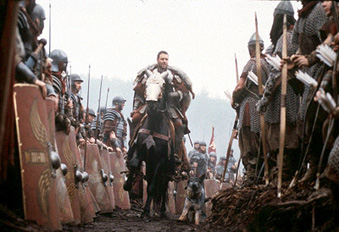
Ganim has also noted that despite the numerous interior scenes that set Kingdom of Heaven apart from other “medieval Easterns” (a term denoting the genre’s borrowing of the spatial language of the Hollywood Western), its depiction of the siege of Jerusalem strongly resembles the spectacular siege sequences in Peter Jackson’s The Lord of the Rings: The Two Towers (USA/New Zealand/Germany 2002).[23]
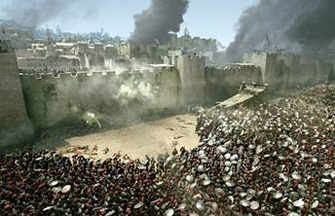
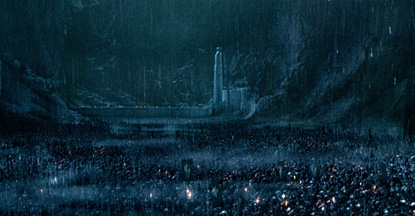
The point of these observations is not to offer a gleeful catalogue of the film’s historical failures, but to point out the extent to which Ridley Scott’s recreative medievalist impulse combines with, indeed relies on, a cinematic visual idiom of generalised ‘heroic pastness’ in which the historical Middle Ages collapses amnesiacally into the epic classical past of the sword-and-sandals genre and, indeed, the sword-and-sorcery fantasy of cinematic Tolkienism.[24] So the recollective amnesia in which Kingdom of Heaven entreats its audience to engage involves a forgetting of the differences between medieval and classical pasts, and medieval history and medievalist fantasy – and, as I have been discussing, the Middle Ages and the present. It is precisely this long, intractable history of East-West warfare evoked by the film’s visual idiom that its audience is asked to renounce in the name of post-historical conscience.
Kingdom of Heaven’s evocation of a generalised heroic past brings it into unexpected but apt alignment with its bellicose stablemate 300, whose battle scenes are also unmistakably reminiscent of the monstrous clashes in the Lord of the Rings franchise. This is particularly the case in the later confrontations between the Spartans and Xerxes’ immortals, who are presented as human-monster hybrids in the vein of the hideous and numberless orcs of L.O.T.R. It is virtually impossible to watch the unleashing onto Leonidas of the so-called “über-immortal”, a misshapen human giant with sharp gnashing teeth, without recalling the gargantuan Maori-Rastafarian ‘super-orc’ of L.O.T.R.: The Fellowship of the Ring’s Uruk-hai.
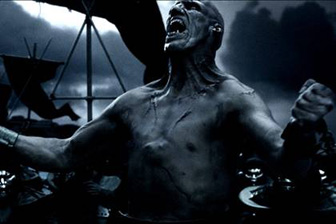
It is equally impossible, as a number of commentators have noted, not to see L.O.T.R.’s treacherous subterranean Gollum in 300’s deformed Spartan traitor Ephialtes.
What we have, in this case, is an inversion of Kingdom of Heaven’s sword-and-sandals medievalism; that is, a film in which fantastic medievalism inflects heavily the representation of classical warfare. Neither the classical nor the medieval is cinematically legible without some element of one another. Both films also borrow from the aesthetic register of fantastic medievalism’s hard-edged musical cousin, heavy metal. In 300 this is brazenly evident, its occasional pounding guitar riffs reinforcing the metal front-man aesthetic of Butler’s Leonidas. Kingdom of Heaven’s engagement with metal medievalism is more restrained; nevertheless in the early skirmish featuring the Germanic warrior Odo (Jouko Ahola) – his long blond plaits, bulging muscles and leather vest evoking the Teutonic aesthetic of much heavy metal – the faint but unmistakable sound of searing electric guitar can be heard, woven playfully into the orchestral soundtrack.
Compiling a list of these films’ ‘multi-temporal’ moments would be a critical redundancy. What is more important is that an acknowledgement of the significant cross-over in their visual idiom, especially in their depictions of armed conflict, raises the important question of whether 300 and Kingdom of Heaven can be described easily as ‘classicist’ and ‘medievalist’ films, or whether their comparison calls for another way of thinking about the representation of the heroic past, that transcends the limitations of periodisation. This might seem like a fairly obvious point to be making; yet it chafes against the current orthodoxy within scholarship on medievalist and classicist cinema, both of whom, with no sign of dialogue between them, lay equal claim to the primacy of their respective periods in the popular cinematic imaginary. Just as classicists might argue that Haydock’s argument for “the ubiquity of the analogies between the medieval world and present-day [East/West] conflicts” is mitigated by a consideration of recent classical ‘clash of civilisations’ films such as 300, Troy (USA/Malta/UK 2004), and Alexander (Germany/USA/Netherlands 2004), so too can medievalists query the periodising cordon sanitaire drawn unquestioningly around Greco-Roman culture by classicist cinema scholars such as Kirsten Day. Day’s recent comment that cinematic and televisual adaptations of ancient myths and history “utilize intersections between past and present that touch on concerns and anxieties common to ancient and modern audiences alike”,[25] while perhaps less vehement than Haydock in its historical stake-holding, nevertheless forms part of her argument for the particular significance of the ancient world as a cinematic mirror for such recent political concerns as that fates of global empires, democracy, and cultural decadence. A medievalist counter-charge might list such recent medievalist engagements with contemporary politics as King Arthur (USA/UK/Ireland 2004), Braveheart (USA 1995) – and, of course, Kingdom of Heaven.
Interestingly, both fields seem to have reached a comparable stage of sophistication about the necessity of ‘reading’ historical film for its contemporary meanings and eschewing the ideal of historical accuracy. But this sophisticated acceptance of adulterated representation, in which periodisation is not scrupulously observed, continues to sit at odds with both fields’ desire to argue for their respective premoderns as uniquely significant to the modern. In pointing to this tension, I do not wish to dispute the idea that in many films the medieval or classical content, even in an ‘adulterated’ multi-temporal form, has a particular significance that is not available in other epochs. Indeed, at the most obvious level, the Hellenic context of 300 facilitates a more focused meditation on democracy and despotism, while Kingdom of Heaven’s Crusades setting foregrounds an exploration of the relationship between religious conflict and Realpolitik. But I want to conclude by suggesting two alternative ways those of us in the historical disciplines can approach the putative uniqueness of ‘our’ historical periods in cinema.
The first, which I hope this essay has demonstrated, is that the contemporary significance of a particular period on film can sometimes best be explored not by examining a range of films from the same period, but by bringing a film from one period into dialogue with a film from another. Even if historians are unwilling to relinquish periodisation in relation to history – although it has been met with some serious challenges within medieval studies in recent years – it seems counter-intuitive to, on the on hand, accept cinema’s historical impurity and yet, on the other hand, to insist on maintaining periodisation in cinema studies. The second is that we need to be responsive to the possibility that the ahistorical idiom of certain historical films – and in my view 300 and Kingdom of Heaven are in this category – may require us to accept that their historical settings in fact only play a supporting role, servicing not only contemporary ideological and political concerns, but also, under the star of a less critically chic humanism, explorations into perceived ‘universal’ themes: conflict, freedom, conscience, and morality. Films such as these ask us to embrace the idea that the ‘history lesson’ they teach might ultimately be a species of historical amnesia. But, for all this, they are not exceptional: for in the end, the impurity of historical cinema means that recollective amnesia is not the exception but the rule.
Endnotes
[1] Richard Alleva, “Bogs of War”, Commonweal 134, no. 10, (18 May 2007): 16-17; A. O. Scott, “Battle of the Manly Men: Blood Bath With a Message”, New York Times, 9 March 2007; Hywel Williams, “The Pecs that Saved Greece”, The Guardian, 21 March 2007.
[2] Mike Chopra-Gant’s introductory Cinema and History: Telling Stories (London and New York: Wallflower, 2008) selects a diverse set of texts to discuss cinematic ‘history-writing’; William Howard Guynn’s Writing History in Film (New York: Routledge, 2006) uses a more restricted but still eclectic sample of case studies, while Warnie Hughes-Warrington’s History Goes to the Movies (New York: Routledge, 2007), ranges widely across historical settings.
[3] Richard Alleva, “Bogs of War”, 16.
[4] Slavoj ?i?ek, In Defense of Lost Causes (London and New York: Verso, 2008), 71.
[5] Mustapha Marrouchi, “Neither Their Perch nor Their Terror: Al Qaida Limited”, Callaloo, 31, no. 4 (2008): 1341.
[6] Frank. J. Wetta, “Film Review: 300”, The Journal of Military History, 72, no. 2 (April 2008): 632.
[7] Williams, “The Pecs that Saved Greece”, 36.
[8] Marrouchi, “Neither Their Perch nor Their Terror”, 1342.
[9] Bradshaw, “Greek Travesty: Review of Zack Snyder’s 300”, The Guardian, 23 March 2007.
[10] It is difficult to overlook the irony here that just as the U.S. claims about Iraq’s possession of WMDs turned out to be unfounded, so too the Persian WMDs in this film have been created by digital animation.
[11]Williams, “The Pecs that Saved Greece”, 36.
[12] Hamid Dabashi, “Warriors of faith”, Sight and Sound XV, no. 5 (May 2005): 25.
[13] Caroline Biddick, “Unbinding the Flesh in the Time that Remains: Crusader Martyrdom Then and Now”, GLQ13, nos. 2-3 (2007): 217.
[14] Arthur Lindley, “Once, Present, and Future Kings: Kingdom of Heaven and the Multitemporality of Medieval Film”, in Race, Class, and Gender in “Medieval” Cinema, eds. Lynn T. Ramey and Tyson Pugh (New York: Palgrave MacMillan, 2007), 16.
[15] Lindley, “Once, Present, and Future Kings”, 21.
[16] Quoted in Charlotte Edwardes, “Ridley Scott’s New Crusades Film ‘Panders to Osama bin Laden”, Daily Telegraph, 18 January 2004, http://www.telegraph.co.uk/news/worldnews/northamerica/usa/1452000/Ridley-Scotts-new-Crusades-film-panders-to-Osama-bin-Laden.html. Accessed June 15, 2009. See also Lindley, “Once, Present, and Future Kings”, 18-19.
[17] Dabashi, “Warriors of Faith”, 27.
[18] Biddick, “Unbinding the Flesh”, 216.
[19] Jacques Derrida. “Plato’s Pharmacy,” in Dissemination, trans. Barbara Johnson (London: The Athlone Press, 1981), 69, 99, and 127.
[20] Risden, “Nobody But the Other Buddy: Hollywood, the Crusades, and Buddy Pictures”, in Hollywood in the Holy Land: Essays on Film Depictions of the Crusades and Christian-Muslim Clashes, eds. Nickolas Haydock and E. L. Risden (Jefferson, North Carolina, and London: McFarland & Company, Inc., 2009), 193.
[21] Haydock, “Introduction: ‘The Unseen Cross upon the Breast’: Medievalism, Orientalism, and Discontent”, in Hollywood in the Holy Land, 13. Medievalist scholar Bruce Holsinger has also strongly critiqued the medieval-oriental collocation, arguing “post 9-11 medievalism became a dominant … paradigm for comprehending the identity, culture, and motivations of American’s perceived enemy … [and] a reservoir of descriptive fallacy and misrecognition in America’s prosecution of global war”. Neomedievalism, Neoconservatism, and the War on Terror (Chicago, Prickly Paradigm Press, 2007), v.
[22] John Ganim, “Framing the West, Staging the East: Set Design and Landscape in Movie Medievalism”, in Hollywood in the Holy Land, 40.
[23] Ganim, “Framing the West, staging the East”, 40.
[24] Ganim, Lindley, and others would add to this ‘pastness’ the Hollywood Old West.
[25] Kirsten Day, introduction to special issue “Celluloid Classics: New Perspectives on Classical Antiquity in Modern Cinema” Arethusa 41 no. 1 (Winter 2008), 3.
Created on: Monday, 21 December 2009

